Physical Address
304 North Cardinal St.
Dorchester Center, MA 02124
Dermatopathology of the nail unit remains a somewhat esoteric and elusive subject for several reasons. Most dermatopathologists have little experience with material from this site, and little has been written comprehensively about this subject. Part of the difficulty stems from the fact that many dermatologic conditions affecting the nail unit are diagnosed on clinical grounds alone, in part owing to the reluctance of practitioners to perform biopsies at this site, especially if diagnostic lesions are present elsewhere on the skin, and of patients to submit to such a procedure. Clinicians and pathologists alike may also have limited knowledge of the normal anatomy of this site and of diseases that affect it. This has a tendency to result in suboptimal specimens and interpretation of them. Disorders at other cutaneous sites may have similar histologic appearance when expressing themselves in the nail unit, but there are some differences, as a result of the peculiarities of the nail anatomy, that may create diagnostic difficulty. This chapter reviews the gross and microscopic anatomy of the nail unit; describes methods of biopsy appropriate to this area and the types of specimens that result; and illustrates select more commonly encountered or distinctive inflammatory, infectious, and neoplastic disorders that affect it.
The nail unit includes the nail matrix and nail bed and their product, the nail plate. Important sheaths, including the cuticle, also produced by nail unit epithelium protect the nail from the environment ( Fig. 18-1 ). Epithelial folds and grooves provide protection and framing. There are also fibrocollagenous supportive tissues. Clinically, the lunula corresponds to the distal matrix. The proximal nail matrix lies well behind the proximal nail fold. The proximal nail fold may cover the matrix to varying degrees. The lunula can generally be observed best on the thumbs and hallux. The matrix produces the bulk of the nail plate. The cuticle (or false cuticle as it is also known) emanates from the proximal nail fold and adheres to the nail plate. The true cuticle, produced by the undersurface of the proximal nail fold (eponychium), is rarely visible but forms an important sheath to protect the nail unit. From the lunula to the onychodermal dermal band lies the nail bed. It makes a small contribution to the undersurface of the nail plate. The onychodermal band is the last point of attachment of the nail plate to the nail bed. The free edge of the nail covers the hyponychium, the most distal portion of the nail unit.
Nail matrix: responsible for nail plate production
Nail bed: assures nail plate adhesion
Proximal nail fold: protects nail production
Nail growth rate:
Fingernails: 3 mm/mo
Toenails: 1 mm/mo
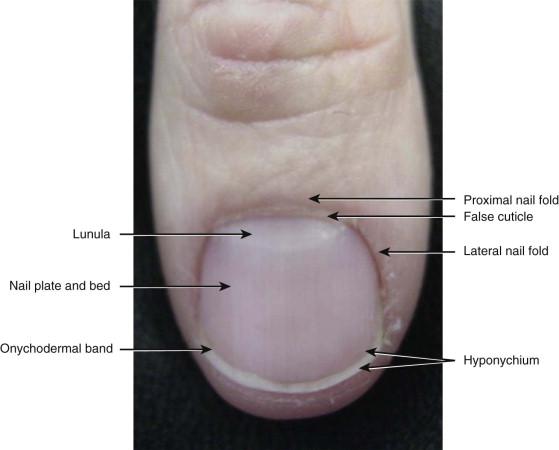
The nail matrix epithelium consists of gently rounded ridges, called mamelons, that angle toward the tip of the digit and become progressively flattened in transition to the nail bed epithelium ( Fig. 18-2 ). The keratinocytes of the lower matrix are basaloid, and they flatten and become more eosinophilic as they keratinize abruptly along the keratogenous zone to form the nail plate. The nail plate, composed of hard and soft keratins, is formed via onychokeratinization, which has many similarities to trichilemmal keratinization. Keratinization is abrupt and occurs without a granular zone. There may be several normally inapparent layers in the nail plate.
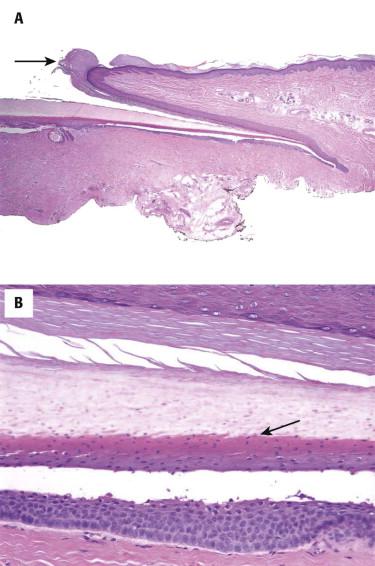
The proximal matrix produces the superficial aspects of the plate (roughly one third); the dorsal matrix produces a very thin surface layer of the plate, giving it its luster; and the distal matrix the remaining lower two-thirds, with a small contribution from the nail bed. These features explain how nail pitting occurs via insults to the proximal matrix and how proximal matrix damage produces more obvious nail plate deformity. The nail unit also shares some of the same keratin subunits seen in hair. Unlike in keratinization of hair, there are no trichohyalin granules, nor are there keratohyaline granules. In fact, keratohyaline granules or a granular zone of the nail matrix or bed are pathologic findings in the nail unit. These features can be seen nonspecifically in a variety of conditions, including psoriasis, lichen planus, trachyonychia, and onychomycosis, and can also be seen in the setting of trauma or neoplasms, which create pressure on the nail matrix or otherwise disrupt nail unit architecture. Nail matrix hypergranulosis as a response to various insults may be more analogous to parakeratosis at cutaneous sites.
The nail bed that occurs beyond the keratogenous zone of the matrix ( Fig. 18-3 ) contains a thinner and more eosinophilic epithelium, whose parallel ridges (not rete) are oriented longitudinally and interdigitate in “tongue and groove” fashion with the underlying dermis. There is also interdigitation with the underside of the nail plate, producing longitudinal striations. This pattern of ridges can only be appreciated when examining transverse “cuts” through the nail bed (from side to side) and is thus often not evident in longitudinal biopsies. These architectural features lead to the appearance of splinter hemorrhages over the nail bed. Trauma to the distal vessels leads to hemorrhage, which accumulates in the grooves. Although the derivation of the nail plate has been a subject of debate among nail aficionados, many recent studies indicate that the nail matrix gives rise to the bulk of the nail plate, with only a scant contribution from the nail bed, mainly to its underside. The nail bed may make more of a contribution in the setting of certain diseases.
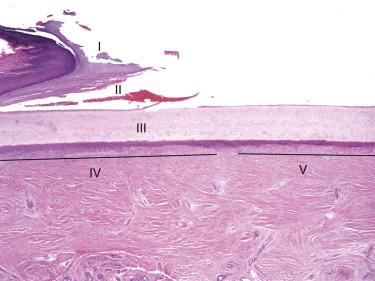
The framing of the nail unit consists of the proximal and lateral nail folds and grooves, which transition to the acral skin surrounding the nail unit. These provide structural support to the nail plate and protect it from trauma. The folds also give rise to the sheaths, which further protect the nail plate. The sheaths include the cuticles, hyponychium, and onychodermal band. The true cuticle arises from the ventral surface of the proximal nail fold (eponychium) and is formed of semihard keratin by onycholemmal keratinization. It blends with the surface of the nail plate. The solehorn, a barely visible zone that forms at the undersurface of the distal nail plate, is similar. The false cuticle (the one we generally think of as the cuticle) is visible as an extension of the apex of the proximal nail fold. It keratinizes, as do normal acral skin, and the hyponychium. Chronic diseases, especially those that lead to cessation of nail growth or trauma to the proximal nail fold lead to a loss of the cuticle and rounding up of the proximal nail fold, allowing for further damage to the nail unit, as in the paronychia. The hyponychium is the distal counterpart to the eponychium, also forming a seal around the nail unit and a transition to the surrounding skin. It also keratinizes via a granular layer. The hyponychial attachment to the nail plate can be seen under the plate as the onychodermal band.
There is no distinct papillary or reticular dermis in the nail unit, nor is there subcutaneous fat except at its periphery on acral skin. There are also no adnexa in the nail unit except for sweat glands in the dorsal aspect of the proximal nail fold. There are specialized nerve endings in these areas, including meissnerian and pacinian corpuscles, as well as specialized vascular shunts, the glomus apparati. The dermis is often myxoid. Recent studies have suggested a specialized “onychodermis” of the nail unit.
Sampling the nail unit presents special problems. A punch or shave biopsy on other cutaneous sites is relatively straightforward, but in the nail unit, there are unique considerations from a technical and functional standpoint. Some techniques are better than others as far as obtaining tissue suitable for diagnosis while preserving cosmesis and function for the patient. Damage to the nail matrix, especially the proximal matrix, can result in permanent nail dystrophy. The procured tissue must be handled with utmost care. Communication of the submitting clinician with laboratory staff and pathologists is essential for ensuring proper handling of the specimen.
Most commonly used biopsy techniques, such as punch, shave, or excision, can be used for nail unit sampling, but the barrier of the nail plate can present challenges to obtaining a biopsy suitable for interpretation. En bloc longitudinal excisional biopsy is the gold standard and usually mitigates some of the problems with disruption of the nail epithelium that can occur using other methods. This procedure generally includes the entire length of the nail unit, including proximal nail fold, nail matrix, nail bed, hyponychium, and nail plate. As in the case of excisional biopsies of melanocytic neoplasms elsewhere, such a procedure is optimal for allowing complete assessment of symmetry and circumscription of melanocytic lesions and to avoid compression artifact. They can also be very useful in evaluating nail dystrophy when it may not be clear clinically which component of the nail unit is responsible for it.
Nail matrix biopsies are often performed for evaluation of melanocytic lesions, which usually arise in the distal matrix, and for some inflammatory disorders. They can be obtained via a punch biopsy through the proximal nail fold and nail plate to the matrix, but this represents a somewhat blind technique because the area of pigmentation responsible for the pigmented band is not directly visualized. A preferable technique involves incising and retracting the nail fold to expose the proximal nail plate, transversely incising and gently removing the proximal plate, and then directly sampling the matrix by a punch or shave technique. Another technique involves avulsing the entire nail plate first to expose the underlying matrix and bed, at which point a punch or shave biopsy can be done. This has a tendency to cause more disruption to the underlying epithelium. And leaving the distal nail plate in place can be a benefit to function during the healing process. Regardless of the method, careful attention much be given to avoid crushing the delicate specimen containing the nail epithelium. The nail plate should also be submitted because a substantial amount of superficial epithelium may accompany it and hold diagnostic clues. Punch biopsies of the nail bed are often sufficient for diagnosis of inflammatory and some neoplastic conditions and may avoid resultant nail dystrophy.
Orientation of the specimen with respect to which area of the nail unit was sampled should also be provided to the laboratory, along with any specific instructions, to make sure the specimen is properly handled. Small biopsies benefit from being placed on a piece of cardboard or paper and then in formalin to preserve orientation of the nail matrix epithelium and prevent curling of thin specimens. Ideally, the pathologist should be closely involved in grossing these specimens or providing guidance to the laboratory team. When sectioning of the specimen is involved, a longitudinal plane is preferred to maintain orientation of all components of the nail unit. Although some softening techniques can help in preparing and processing the specimen if it contains nail plate, including calcium or sodium hydroxide preparation and cedarwood oil processing, it is unknown how these techniques might affect ancillary studies, such as immunoperoxidase staining of epithelium. There is certainly no place for decalcification per se unless bone is present. However, a simple technique can be done at the time of cutting paraffin-embedded sections and does not have notable secondary effects. Soaking the paraffin block briefly on a water bath can hydrate the nail plate, making the cutting smoother, and help prevent nail tissue from popping out of the paraffin block. Albumin can be used to help the sections remain on the slide during staining.
Most pathologists have experience with this type of specimen, although they may not have received much training in how to interpret it. Common uses include diagnosis of onychomycosis, Pseudomonas infection, nail bed psoriasis (which can avoid deeper sampling and nail disruption), and nail plate hemorrhage versus melanin. Distal clippings or avulsed nail plate may be submitted.
Examination of nail clippings with periodic acid-Schiff with diastase digestion (PAS-D) or Gomori methenamine silver stain for diagnosis of onychomycosis (e.g., dermatophyte or tinea unguium, Candida , mold) is the most sensitive method for diagnosis (≈70%), more sensitive even than fungal culture, and much faster. It does not allow for identification of the precise organism(s), of course, although there may be some clues to the presence of nondermatophytes. If more specificity is desired, culture should also be performed. Treatment decisions often depend on whether dermatophytic fungi or yeast and mold are present and how extensive the infection is. It is important to sample the nail plate and subungual material when submitting such a specimen because subungual material usually harbors the microorganisms more consistently except in superficial infections (clinically, white superficial onychomycosis). If little subungual material is submitted, this can create a false-negative result. However, any part of the nail plate or all of it may be involved ( Fig. 18-4 ). It is also important to examine each portion of nail submitted because sometimes hyphae are few in number, especially if there has been partial treatment. Longer septate hyphae and occasionally spores will be evident in dermatophytic infections. Ballooned forms can also be seen when degenerating fungi are present. Pigmented onychomycosis is an ever-increasing diagnosis as well, especially in warmer or tropical climates. This infection often creates melanonychia in a sense because the fungal walls actually contain melanin. Thus, it is a frequent mimicker of melanocytic neoplasms. This underscores the importance of submitting nail plate in cases of melanonychia. Molds such as Scopulariopsis, Scytalidium, and Trichophyton rubrum nigricans are often implicated. They may be encountered as large irregular branching, truncated, and sometimes perforating hyphae and spores. Candidal yeasts are often present under or within the nail plate (see Fig. 18-4 ). It is a matter of debate as to whether they are true pathogens, probably a rarity except in immunodeficiency states, or more often colonizers of an abnormal nail unit. They are, as expected, usually manifest as smaller spores and pseudohyphae, with budding ( Fig. 18-5 ). Incidental Pityrosporon from surrounding skin can be present as well. Bacteria are often present nonspecifically, especially if distal nail plate is submitted, but may be observed in paronychia. Exogenous material may also be observed, including nail polish.
![FIGURE 18-4, Onychomycosis. A and B, Tinea unguium, with dermatophytic hyphae throughout the nail plate and within subungual debris (periodic acid-Schiff with diastase digestion [PAS-D] stains). C, Pigmented superficial onychomycosis with pigmented fungi embedded in the surface of the nail plate. D, Onychomycosis caused by mold, with irregular branching thick hyphae that perforate the nail plate at irregular angles (PAS-D stain). FIGURE 18-4, Onychomycosis. A and B, Tinea unguium, with dermatophytic hyphae throughout the nail plate and within subungual debris (periodic acid-Schiff with diastase digestion [PAS-D] stains). C, Pigmented superficial onychomycosis with pigmented fungi embedded in the surface of the nail plate. D, Onychomycosis caused by mold, with irregular branching thick hyphae that perforate the nail plate at irregular angles (PAS-D stain).](https://storage.googleapis.com/dl.dentistrykey.com/clinical/NeoplasticandNonneoplasticDisordersoftheNailApparatus/3_3s20B9780323261913000186.jpg)
![FIGURE 18-5, A, Candidal onychomycosis, featuring small spores and pseudophyphae on the undersurface of the nail plate (periodic acid-Schiff with diastase digestion [PAS-D] stain). B and C, Dermatophytoma, a loculated mass of fungi or mold and bacteria, representing a recalcitrant form of onychomycosis (PAS-D stain). D, Pseudomonas infection, with the typical lemon-yellow hue of the nail plate caused by diffusible fluorescein pigment produced by the bacterium. FIGURE 18-5, A, Candidal onychomycosis, featuring small spores and pseudophyphae on the undersurface of the nail plate (periodic acid-Schiff with diastase digestion [PAS-D] stain). B and C, Dermatophytoma, a loculated mass of fungi or mold and bacteria, representing a recalcitrant form of onychomycosis (PAS-D stain). D, Pseudomonas infection, with the typical lemon-yellow hue of the nail plate caused by diffusible fluorescein pigment produced by the bacterium.](https://storage.googleapis.com/dl.dentistrykey.com/clinical/NeoplasticandNonneoplasticDisordersoftheNailApparatus/4_3s20B9780323261913000186.jpg)
Dermatophytoma is a recalcitrant form of onychomycosis that often presents in an atypical fashion as a mass lesion within or under the nail (or both) and is often loculated. Its structure may reflect the multiple layers of the nail plate. This arrangement is a type of biofilm or populations of microorganisms that adhere to surfaces in an environment organized to make the most use of nutrients and promote their own growth. They can secrete an extracellular matrix, which can create antimicrobial resistance. Fungi in this setting are often thick walled and contain spores and arthroconidia, and they may reproduce at a lower rate, also making them harder to treat. There can be a pure fungal biofilm or with mold and bacteria (see Fig. 18-5 ). This variant may require destructive modalities such as nail avulsion or debridement, and thus it is important for pathologists to mention this finding.
In pseudomonal infection, the nail plate is often greenish clinically and has a characteristic lemon yellow to bright green hue in the lower nail plate histologically caused by fluorescein produced by the bacterium (see Fig. 18-5 ). It also produces pyocyanin, which produces a blue color, together giving blue-green discoloration of the nail clinically. Do not expect to demonstrate the gram-negative organisms in the nail plate, however.
The findings in psoriasis of the nail can arise from involvement of the nail matrix or nail bed (discussed in more detail later). Especially in the case of a thickened nail plate, usually the result of nail bed disease, the avulsed or partially sampled plate alone can be used to make the diagnosis, an easier procedure with less morbidity for the patient. The thickened plate contains serum and more specifically neutrophils, often laminated between layers of the nail plate, with marked subungual parakeratosis with serum and neutrophils and occasional hemorrhage ( Fig. 18-6 ). A PAS-D stain should be part of the evaluation to exclude onychomycosis, which can produce identical changes.
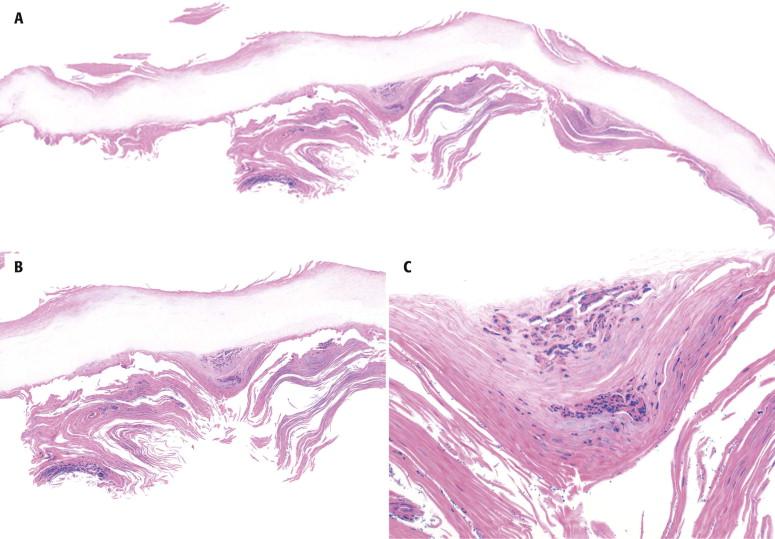
Distinction of subungual hemorrhage from melanin in the nail plate can often be made on clinical grounds and via dermatoscopy. A history of trauma, and better still, an irregular focus of pigment (not just a band) that may not arise from the matrix, with a ragged distal edge, and importantly that grows out with the nail, are features supportive of subungual hemorrhage in the absence of other nail deformity. If a nail matrix biopsy does not seem justified, sampling the affected nail plate can be a first step. Often the presence of blood in the nail plate is readily apparent, in large or small loculations, under or within the nail plate ( Fig. 18-7 ). Be aware that conventional iron stains, such as Perls' or Prussian blue stain, do not work in nail plate specimens. As blood is loculated in an avascular space, it is not degraded to hemosiderin, the form of iron “recognized” by these stains. Instead, a benzidine technique for hemoglobin can be used if needed to help localize small loculations if a careful review does not disclose them. However, because benzidine is a carcinogen and requires special procedures for its use, this is not in common practice. If no hemorrhage is identified, the nail can be stained with Fontana stain to look for melanin. Melanin granules can also be difficult to discern in many cases but when obvious are generally present in an orderly staggered array in nail plate in benign causes of melanonychia (see Fig. 18-7 ). Irregular globules can be concerning, but benign causes of melanonychia such as melanocytic nevi in children can sometimes produce them. A common pitfall in examining Fontana stains of nail plate is the presence of tiny air bubbles under the coverslip, which can be misinterpreted as melanin granules but are more refractile. As a final note, hemorrhage can be associated with melanoma or other nail neoplasms, and melanin can be found in the nail plate after trauma. Thus, nail plate sampling is only a screening procedure, and any suspicious pigmentation is best biopsied in traditional and more ample fashion at its source.
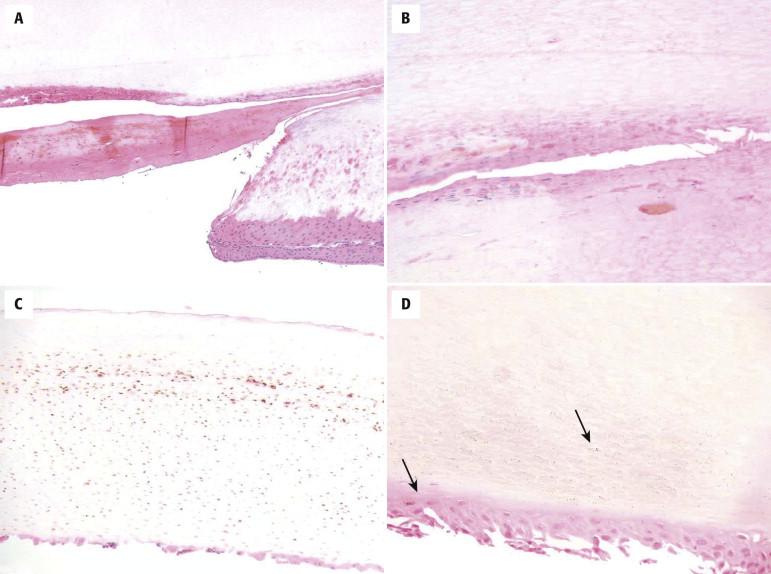
As described earlier, the nail unit can be involved in various infectious diseases, including fungal infection such as onychomycosis and dermatophytoma, candidiasis, and bacterial infections such as Pseudomonas and as a sequela of paronychia. Crusted scabies can also involve the nail and sometimes be a reservoir for reinfection in treated patients.
Many dermatologic conditions may also involve the nail unit, but if lesions exist elsewhere, they are generally biopsied for diagnosis preferentially. The diseases discussed here may be the sole manifestations of their conditions or so commonly involved that a biopsy is more often undertaken.
Psoriasis can affect the nail matrix or nail bed, as well as periungual skin. Diagnostic findings are usually more evident in fingernails; toenail involvement is often identical clinically to onychomycosis. Clinically, when the proximal matrix is affected, there are superficial nail plate changes, such as pitting, crumbling, and roughening, that are rarely an impetus for biopsy. These findings result from zones of parakeratosis of varying extent on the surface of the nail plate. Involvement of the mid to distal nail matrix produces leukonychia (whitening), resulting from parakeratosis of the deeper aspects of the nail plate. “Oil spots” or “salmon patches” result from involvement of the nail bed, which can demonstrate spongiosis (not seen in typical cutaneous psoriasis), resultant accumulation of serum, parakeratotic subungual debris, and neutrophils, producing pink or orange to brown discoloration. Disease affecting the distal nail bed and hyponychium usually manifest as onycholysis (separation of nail plate from the bed) or subungual debris or thickening. Onycholysis and oil spots are commonly found adjacent to one another. Nail disease is often accompanied by psoriatic arthropathy.
Biopsies to prove psoriasis are generally taken from the nail bed because this zone is more commonly affected in severe disease in which treatment is contemplated, and a biopsy from this zone tends to produce less nail dystrophy. A longitudinal biopsy is often done, however, when it is unclear which compartment is responsible for the nail dystrophy. The affected epithelium demonstrates many similar features to psoriasis elsewhere ( Fig. 18-8 ). The nail bed epithelium is acanthotic, with elongated and sometimes thin ridges and parakeratosis with serum and neutrophils. The epithelium may also be thin between ridges, and there are dilated capillaries within dermal papilla, which also produce characteristic splinter hemorrhages, the nail unit equivalent of Auspitz sign. Unusual features include spongiosis, more often seen in acral psoriasis in general but usually still accompanied by neutrophils. Pustules may develop in so-called acrodermatitis of Hallopeau (see Fig. 18-8 ). Also, chronic or onycholytic lesions may lose characteristic features, resembling lichen simplex chronicus (LSC), with hypergranulosis (never a normal finding on the nail bed), but still retain the elongate ridges expected in psoriasis. The clinical and histologic differential diagnosis includes mainly dermatophytosis and candidiasis, which should be excluded by PAS-D stain. Nail plate biopsies, as discussed earlier, can be helpful in this setting. Lichen planus and eczematous nail disease may also enter into the differential diagnosis.
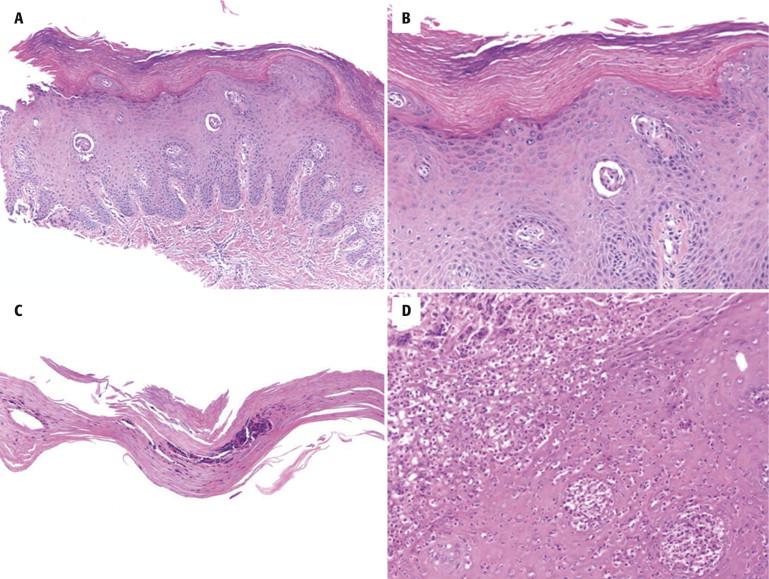
Lichen planus of the nails can present a variety of clinical features and may affect any or all parts of the nail unit. The most common findings are nail thinning and fissuring, longitudinal ridging and splitting, and trachyonychia. In late stages, dorsal nail pterygium may occur. As the epithelium is no longer able to produce nail plate, adherence of the proximal nail fold to nail matrix and bed essentially produces an irreversible syncytium, resulting in permanent nail loss. The clinical and histologic findings in graft versus host disease of the nail unit are nearly identical.
Histologic findings in lichen planus of the nail are similar to those seen in cutaneous disease. Any portion or all of the nail unit can be affected, with a lichenoid lymphocytic infiltrate of varying intensity, necrotic keratinocytes along the junctional zone, hypergranulosis, and irregular hyperplasia of nail unit epithelium ( Fig. 18-9 ). There may be striking hyperkeratosis. In later lesions, the epithelium may be thinned, with foci of hypergranulosis and the infiltrate may be more limited. In such cases, it can be difficult to render the diagnosis. When severe damage has been done, the end-stage changes of pterygium are manifest by loss of normal architecture as above and scarring or loss of the matrix as it fuses with the nail bed and resultant loss of the nail plate (anonychia).
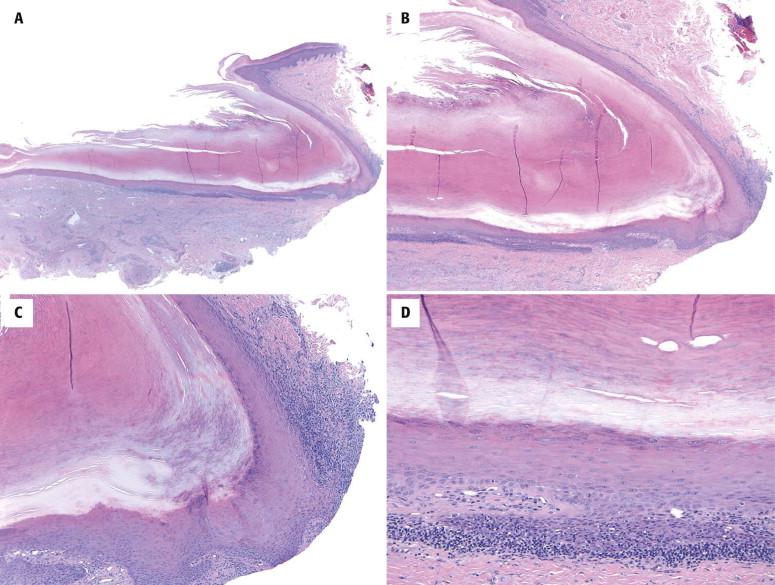
This term refers to thinning and roughening of the nail plate, with striation and distal splitting. It commonly involves many or all nails. A synonymous term is 20-nail dystrophy. This term has fallen out of favor, however, because this condition may involve fewer nails and is likely not a disorder in and of itself but may be the result of several diseases, including lichen planus, psoriasis, and spongiotic (eczematous) disorders. It can also be associated with alopecia areata. Biopsy is often useful in this setting to elucidate the underlying process.
Changes affecting the proximal nail folds, such as periungual telangiectasia, are well known as stigmata of connective tissue disease such as dermatomyositis and lupus erythematosus. Systemic lupus can also involve the nail in 25% of cases, presenting as distal onycholysis and nail bed hyperkeratosis. However, discoid lesions involving the nail unit are rare, and consist of hyperkeratotic plaques. The histologic changes are lichenoid and similar to those seen elsewhere. As disease is never limited to only the nail unit, it is rarely biopsied.
As in cutaneous disease, LSC can be seen as a secondary event in diseases of the nail, such as psoriasis, or a result of overly aggressive nail hygiene or cosmesis (manicure, drummeling, artificial nails). It can also be a primary diagnosis as a consequence of onychotillomania (similar to prurigo nodularis in the skin). In the nail epithelium, as elsewhere, it produces epithelial hyperplasia, a granular zone or hypergranulosis, and hyperkeratosis. The nail plate may be dystrophic or lost. It is important to note that in many conditions in which the nail bed is exposed, for example, in onycholysis, the histologic appearance may be similar to LSC as the nail epithelium reverts to that of acral skin.
The nails are almost never involved in isolation in this papulosquamous disorder, in contrast to psoriasis, and thus biopsies of affected nails are not done routinely. The diagnosis can be confirmed on skin biopsy instead. The clinical findings in pityriasis rubra pilaris of the nail are similar to those of psoriasis but without irregular pitting or oil spots. Studies have shown that the histologic changes consist of patchy parakeratosis mainly over the nail bed and affecting the nail plate, slightly thickened nail bed epithelium, foci of vacuolar change and spongiosis, and a sparse lymphocytic infiltrate. Hyperkeratosis and parakeratosis are present at the hyponychium. Samples of the distal nail plate can sometimes demonstrate the characteristic parakeratosis and hyperkeratosis. The lack of interspersed neutrophils can be helpful in excluding psoriasis or dermatophytosis.
This form of ectodermal dysplasia presents in the nail unit as massive subungual hyperkeratosis, leading to a curved and thickened nail plate. There are two variants, one with associated palmoplantar keratoderma, and oral leukokeratosis (type 1) or with cysts, mild keratoderma, and other ectodermal defects (type 2). Occasional late presentations, occasionally with isolated nail involvement have been reported. The pathology involves a hyperplastic nail bed, which displays papillated hyperplasia with hypergranulosis and marked hyperkeratosis. It results from expression of keratins 6, 16, and 17 by an unknown mechanism. The nail matrix is spared. Nail clippings can suggest the diagnosis in some cases, with massive subungual hyperkeratosis evident ( Fig. 18-10 ).
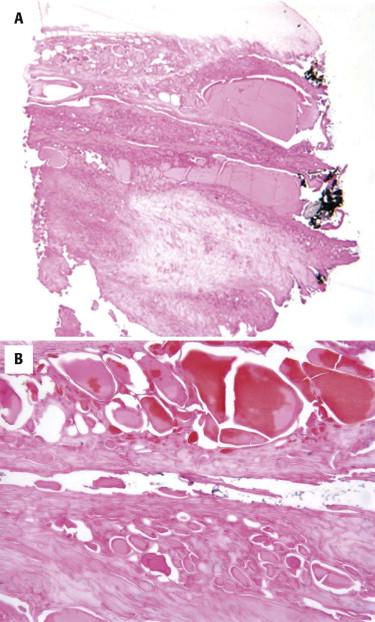
Other mainly inflammatory conditions that can affect the nail unit include eczematous disease, pemphigus vulgaris, pemphigoid, erythema multiforme/toxic epidermal necrolysis, Darier's disease, Hailey-Hailey disease, keratosis punctata, keratoderma, yellow nail syndrome, Langerhans cell histiocytosis, lichen striatus, Sézary syndrome, punctate keratoderma, sarcoidosis, and amyloidosis, among others.
Probably the most common reason to perform biopsy of the nail matrix is in the evaluation of longitudinal melanonychia, or pigmented bands of the nail. When narrow and solitary, these are usually benign and the result of melanocytic activation, lentigines, or melanocytic nevi. Especially in the situation of an irregular, broad, or inhomogeneous band, the chief concern is exclusion of subungual melanoma. Nonmelanocytic conditions can also cause melanonychia, such as pigmented squamous cell carcinoma in situ (SCCIS). Fungal melanonychia, as described earlier, can also cause confusion with a melanocytic neoplasm.
In addition to a basic understanding of the unique histology of the nail unit, one must also obtain as much clinical information as possible before attempting to evaluate any pigmented lesion of the nail unit. It is essential for this information to be provided on any requisition form, but if not, the pathologist should make every effort to obtain it. Most pigmented lesions biopsied display longitudinal melanonychia or a pigmented band and arise from the distal matrix. Key clinical features useful in evaluating a pigmented band have been discussed in many publications and include if the band is solitary or if multiple bands are present, the width of the band, the homogeneity of the band, lateral demarcation of the band (border), Hutchinson's sign (periungual pigmentation), duration and any change over time, which digit and which hand (dominant?) affected, the age of the patient, any extenuating clinical history (drugs, pregnancy, baseline pigmentation, personal or family history of melanoma), and the findings on dermatoscopy. If only one piece of information is given, the width may be the most helpful, just as the size of a pigmented lesion at any other cutaneous site is particularly informative. However, it is important to recognize that even benign lesions may be broad.
Demographic data such as the age of the patient and the digit affected are also very important. For example, melanoma often arises in older individuals, and the thumb and hallux are more commonly affected, as is the dominant hand. It is helpful to know from where the pigment originates and its overall configuration. For example, if it does not involve the matrical zone or is irregular at its free edge, subungual hemorrhage may be its etiology instead of a melanocytic proliferation. The findings on dermatoscopy may also be quite helpful in that particular distinction, although there are limitations of this technique at this site for evaluation of melanocytic neoplasms. Direct intraoperative nail matrix dermoscopy is a novel technique that may prove more helpful in this context. A preoperative clinical photograph can be quite helpful. However, if only a small punch is taken from the proximal portion of the band, with the plate left intact, a postoperative photograph may still contain valuable clues with respect to the remaining band.
Most examples of melanocytic activation, lentigo, and nevus measure 3 to 5 mm or less in width; melanoma tends to display a wider or irregular band. A notable exception is a melanocytic proliferation in a young person, which may be broad but still benign, sometimes displaying complete melanonychia. In melanocytic activation, a narrow tan to gray band or bands are present. Melanocytic activation can be associated with trauma, endocrinopathy, pregnancy, medication, racial pigmentation, Laugier-Hunziker and Peutz-Jeghers syndromes, and a variety of conditions (both inflammatory and neoplastic) that disrupt the nail unit. Most lentigines and nevi display a narrow band with a tan to brown hue. A benign band is generally also relatively homogeneous with respect to color and color intensity, displays regular lines within it, and has sharp edges. Most pigmented lesions producing melanin arise in the distal nail matrix. In general, there should be no periungual pigmentation (Hutchinson's sign). Be aware, however, of the causes of pseudo-Hutchinson's sign, which are discussed in more detail later. One notable example consists of pigmentation transmitted from a heavily melanized matrical lesion through the proximal nail fold without actual extension of the melanocytic proliferation onto that area. This is generally confined only to the breadth of the pigmented band, however, and should not diffuse beyond it. Also, some benign melanocytic neoplasms may involve the periungual skin, in particular congenital nevi.
Although relatively uncommon, nail apparatus melanoma has a poor prognosis, in part because of later diagnosis. Compared with melanoma at other sites, it has a disproportionately higher mortality rate. The 5-year survival rate ranges widely from 16% to 87%, depending on the series, with two larger series in the 51% to 55% range. It has been purported to affect nonwhite patients with higher frequency than does conventional melanoma, but this concept has been called into question more recently, and larger epidemiologic studies may be needed to address this. The relationship to sun exposure for this subtype has not been elucidated, but because the nail plate provides a modest barrier to ultraviolet penetration, this seems less likely. Most nail apparatus melanoma (NAM) arises in the thumb and great toe (hallux), and digits on the dominant hand are also more often affected. It often presents in atypical clinical fashion, with nail dystrophy, and with or without abnormal pigmentation. This, of course, leads to late diagnoses and poor outcomes as a rule. In one larger study, the mean Breslow thickness at diagnosis was 4.8 mm. It may arise in the nail matrix or less often the nail bed. When nail matrix melanoma presents as melanonychia (as it does in roughly 75% of cases), it often produces a band wider than 3 mm, which has widened over time. A disturbing clinical finding is a band wider at the base than the distal edge of the nail, a sign of relatively rapid enlargement. However, in children, this may occur in nevi. The band is often irregular and not crisp at its lateral margins and may be “streaky” or heterogeneous in color.
With time and involvement of the nail bed or periungual tissue, its irregularity becomes more obvious. Involvement of the proximal nail fold and sometimes the hyponychium (Hutchinson's sign, periungual pigmentation) is a fairly diagnostic clue, especially if the pigmentation is also irregular or diffuse. Hutchinson's sign correlates histologically to melanoma in situ in many cases. Causes of pseudo-Hutchinson's sign should be kept in mind, including melanocytic nevi and lentigines, SCCIS, drug-induced pigmentation, trauma, radiation, racial pigmentation, malnutrition, and hemorrhage. Nail plate thinning or fissuring is another concerning feature when seen concurrently with abnormal pigmentation. If the tumor is allowed to progress, a nodule may develop, often with ulceration and nail plate destruction. In addition, amelanotic melanoma often originates in the nail bed, where melanocytes may not produce much melanin pigment. Such lesions are often mistaken for granulation tissue or pyogenic granuloma, squamous cell carcinoma (SCC), or an ingrown nail and thus may elude diagnosis for a prolonged period. An exceptional presentation of amelanotic melanoma in situ is as monodactylic nail dystrophy mimicking lichen planus. Desmoplastic melanoma of the nail unit has also been described. NAM in children is exceedingly rare. Even using accepted clinical criteria such as the ABCDE (Asymmetry, Border irregularity, Color, Diameter, Evolution) rule and dermatoscopic information, the interobserver variation in clinical diagnosis is marked even among experts, and thus histologic examination remains the gold standard.
In addition to knowing the normal anatomy, one must also develop an understanding for the normal density of melanocytes and their distribution at this site, which differs from other cutaneous sites. In normal nail unit epithelium, the quantity of melanocytes is lower than in the skin, about 200/mm 2 compared with around 1150/mm 2 , respectively. They also tend to be inconspicuous in normal matrix. Melanocytes may be found in a suprabasal position in the matrix, especially in the proximal matrix, where they are often located within the lower two to four cell layers. In the distal matrix, they are generally located in the first and second layers. Normally, many of them do not actively synthesize melanin, especially those in the proximal matrix. In the distal matrix, however, approximately 50% synthesize melanin. Melanocytes that normally reside in nail bed epithelium are even fewer (absent to 50/mm 2 ) and do not synthesize melanin. This serves as an explanation as to why melanoma arising from the nail bed tends to be amelanotic and thus a diagnostic difficulty.
From a practical point of view, it is important to have a grasp on the normal density of melanocytes along the basal layer to be able to assess if there is a significant increase, suggesting a melanocytic proliferation. The melanocyte density is generally measured over a 1-mm interval at the epidermal-dermal junction of the nail matrix or nail bed. In normal nails, the density ranges from 4 to 9 melanocytes (mean, 7.7) per 1-mm segment of nail matrix epithelium. Normal matrical melanocytes are generally small and inconspicuous in routine sections, and some may display dendritic processes. They are best highlighted via immunoperoxidase stains, including SOX-10, MiTF (microphthalmia transcription factor-1), HMB45, and Melan-A. Melan-A and HMB45, as melanosome markers, often exaggerate the density of melanocytes, especially in a heavily melanized or dendritic nail melanocytic neoplasm. MiTF and SOX-10, as nuclear stains, give a more accurate assessment of density and location within the matrix. One interesting pitfall that the author has noted is that MiTF also often labels the nuclei of keratinocytes in the upper keratogenous zone of the matrix. Using a red chromogen in heavily melanized proliferations in particular can be helpful in identifying melanocytes in a background of pigmented keratinocytes. It is important to note that S100 immunostain should not be used especially as a single stain because nail unit melanocytes tend not to express this antigen reliably.
Become a Clinical Tree membership for Full access and enjoy Unlimited articles
If you are a member. Log in here